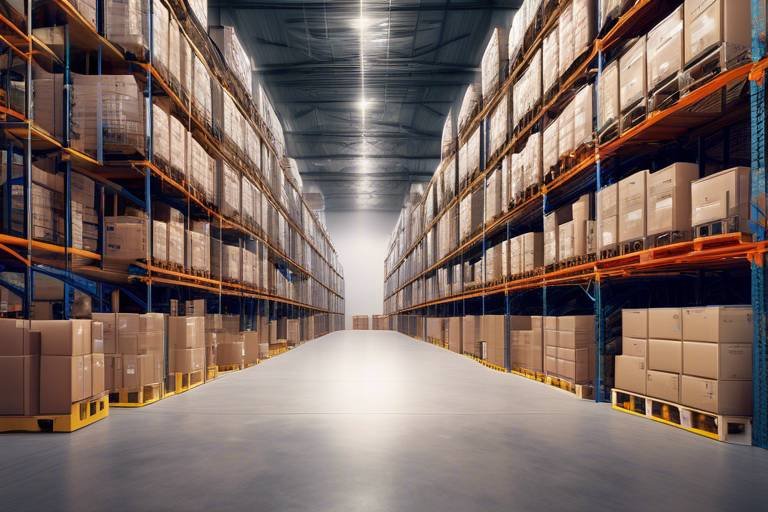How AI is Transforming Supply Chains
In today's rapidly evolving business landscape, the integration of artificial intelligence (AI) in supply chain management is nothing short of revolutionary. Imagine a world where businesses can predict customer demands with pinpoint accuracy, optimize their inventory levels, and streamline logistics operations—all while enhancing their relationships with suppliers. This isn't just a dream; it's the reality that AI is creating for companies across the globe. With AI technologies, businesses are not only cutting costs but also boosting their operational efficiency and customer satisfaction. So, how exactly is AI transforming supply chains? Let's dive into the details.
One of the most significant impacts of AI is in demand forecasting. Traditional methods often rely on historical data and guesswork, leaving companies vulnerable to stockouts or overstocking. However, AI technologies utilize advanced algorithms and machine learning to analyze vast amounts of data, including market trends, seasonality, and even social media sentiments. This allows businesses to anticipate customer needs with remarkable accuracy. By improving demand forecasting, companies can optimize inventory levels, leading to reduced costs and increased efficiency. Imagine being able to predict a surge in demand for a product before it happens—this is the power of AI!
Inventory management can be a daunting task, but AI is here to help. Through sophisticated algorithms, AI assists businesses in managing their inventory more effectively. It minimizes excess stock, which can tie up capital, and reduces the risk of stockouts that can lead to lost sales. The result? Improved operational efficiency and a healthier bottom line. With AI, companies can achieve a fine balance between having enough stock to meet customer demands while avoiding the pitfalls of overstocking. This optimization is akin to walking a tightrope, where the right balance is crucial for success.
Logistics operations are at the heart of supply chains, and AI-driven solutions are making waves in this area. By optimizing routing and reducing delivery times, AI enhances fleet management and logistics efficiency. For instance, AI can analyze traffic patterns, weather conditions, and delivery schedules to determine the best routes for drivers. This not only results in significant cost savings but also boosts customer satisfaction. Think of it as having a personal assistant who knows the best way to get you to your destination, saving you both time and money.
In the realm of supplier relationships, AI tools facilitate better communication and collaboration. By providing insights into supplier performance, businesses can negotiate contracts more effectively and mitigate risks. This leads to stronger partnerships and improved supply chain resilience. Imagine having a dashboard that displays real-time data on your suppliers' performance—this transparency allows for proactive decision-making and fosters a collaborative environment.
Quality control is another area where AI shines. With real-time monitoring and analysis of product quality, companies can identify defects early in the production process. This proactive approach helps maintain high standards and reduces the likelihood of costly recalls. Think of it as having a vigilant inspector who never misses a detail, ensuring that only the best products reach the market.
AI's capabilities extend beyond just supply chain processes; it also plays a vital role in equipment maintenance. By analyzing data from machinery, AI can predict equipment failures before they occur. This means businesses can perform timely maintenance, reducing downtime and keeping operations running smoothly. It's like having a crystal ball that warns you of potential issues, allowing you to take action before they become a problem.
Order processing can be tedious and prone to human error, but AI is changing the game. By automating routine tasks, AI reduces the chances of mistakes and accelerates the order fulfillment cycle. This not only enhances the customer experience but also frees up valuable time for employees to focus on more strategic tasks. Imagine a world where orders are processed in the blink of an eye—this is the efficiency that AI brings to the table.
Finally, AI empowers supply chain managers with actionable insights derived from data analytics. This data-driven approach enables informed decision-making that drives strategic initiatives and gives businesses a competitive edge. In a world overflowing with data, AI acts as a compass, guiding managers through the noise to make decisions that matter.
The integration of AI in supply chains is just the beginning. Emerging trends such as autonomous vehicles and blockchain technology are set to further revolutionize logistics and operations in the coming years. As these technologies evolve, they will create new opportunities for efficiency and innovation, transforming the way businesses operate.
- What is AI in supply chain management? AI in supply chain management refers to the use of artificial intelligence technologies to optimize various aspects of the supply chain, including demand forecasting, inventory management, and logistics.
- How does AI improve demand forecasting? AI improves demand forecasting by analyzing large datasets to identify patterns and trends, allowing businesses to make more accurate predictions about customer needs.
- What are the benefits of AI in inventory management? The benefits include reduced excess stock, minimized risk of stockouts, and improved operational efficiency.
- Can AI help with supplier relationship management? Yes, AI can enhance communication and collaboration with suppliers, providing insights into performance and facilitating better negotiations.

Enhancing Demand Forecasting
In today's fast-paced market, where customer preferences can change at the drop of a hat, accurate demand forecasting is more crucial than ever. Enter artificial intelligence (AI), a game-changer that is revolutionizing how businesses predict customer needs. With the power of AI, companies can analyze vast amounts of data to identify patterns and trends that were previously invisible to the naked eye. Imagine being able to foresee what your customers will want before they even know it themselves! That's the magic of AI.
AI technologies, particularly machine learning algorithms, can process historical sales data, seasonal trends, and even external factors like economic indicators or weather patterns. This comprehensive analysis allows companies to create highly accurate forecasts that minimize waste and optimize inventory levels. For instance, a retail company can predict a surge in demand for winter jackets as the temperature drops, ensuring they have enough stock on hand to meet customer needs without overstocking and tying up capital in unsold goods.
Moreover, the integration of AI into demand forecasting isn't just about crunching numbers; it's about enhancing agility. Businesses can respond quickly to changes in demand, adjusting their strategies in real-time. This agility is crucial in avoiding stockouts, which can lead to lost sales and dissatisfied customers. Think of it this way: AI acts as a crystal ball, giving businesses the foresight they need to navigate the uncertainties of the market.
To illustrate the impact of AI on demand forecasting, consider the following table that highlights the traditional forecasting methods versus AI-driven approaches:
| Aspect | Traditional Methods | AI-Driven Methods |
|---|---|---|
| Data Processing | Manual analysis of historical data | Automated analysis of vast datasets |
| Accuracy | Often relies on intuition | High accuracy through predictive analytics |
| Response Time | Slow adjustments to market changes | Real-time adjustments based on live data |
| Scalability | Difficult to scale with increasing data | Seamless scalability with cloud-based solutions |
As we move forward, the role of AI in demand forecasting will only grow. Companies that embrace these technologies will not only enhance their forecasting capabilities but also gain a competitive edge in their respective markets. With AI, businesses can turn uncertainty into opportunity, aligning their products with customer demand and driving profitability.
In conclusion, enhancing demand forecasting through AI isn't just about improving accuracy; it's about transforming how businesses operate. The ability to predict customer needs accurately allows companies to be proactive rather than reactive, ensuring they remain one step ahead in an ever-changing landscape.
- What is demand forecasting? Demand forecasting is the process of predicting future customer demand for a product or service based on historical data and market analysis.
- How does AI improve demand forecasting? AI improves demand forecasting by analyzing large datasets quickly and accurately, identifying patterns, and providing insights that traditional methods may miss.
- What are the benefits of accurate demand forecasting? Accurate demand forecasting helps businesses reduce costs, minimize stockouts, optimize inventory levels, and enhance customer satisfaction.
- Can small businesses benefit from AI in demand forecasting? Absolutely! AI tools are increasingly accessible and can help small businesses make informed decisions and compete effectively in the market.

Optimizing Inventory Management
In the fast-paced world of supply chain management, inventory management can often feel like a game of chess—where one wrong move could lead to costly mistakes. Fortunately, artificial intelligence (AI) is stepping in as a strategic partner, helping businesses make smarter, data-driven decisions that enhance efficiency and profitability. Imagine having a crystal ball that not only tells you what products will fly off the shelves but also predicts when they will do so. This is the power of AI in optimizing inventory management.
AI algorithms analyze vast amounts of data from various sources, including sales trends, seasonal fluctuations, and even social media sentiments, to forecast demand accurately. This allows companies to maintain the right amount of stock without overcommitting resources. For instance, a retailer using AI can predict that a particular toy will be in high demand during the holiday season, enabling them to stock up in advance and avoid the dreaded stockout scenario. The result? Happier customers and improved sales.
Moreover, AI doesn't just stop at forecasting. It also plays a crucial role in inventory optimization. By continuously monitoring stock levels in real-time, AI systems can identify patterns and suggest optimal reorder points. This ensures that businesses can act swiftly to replenish their inventory before it runs low. Think of it as having a smart assistant that nudges you to restock your pantry just before you run out of your favorite snacks. This proactive approach minimizes excess stock, reducing holding costs and waste.
Another significant advantage of AI in inventory management is its ability to enhance supply chain visibility. With AI-powered dashboards, businesses can gain insights into their entire inventory lifecycle—from procurement to warehousing and distribution. This transparency allows for better collaboration among teams and partners, ensuring that everyone is on the same page. For example, if a supplier is experiencing delays, an AI system can alert the inventory manager, who can then make informed decisions to mitigate potential disruptions.
However, while the benefits of AI in inventory management are substantial, there are challenges to consider. Implementing AI solutions requires an initial investment in technology and training. Additionally, companies must ensure they have access to clean, accurate data; otherwise, the insights generated may lead to misguided decisions. It's a bit like trying to bake a cake without the right ingredients—no matter how fancy your mixer is, the end result won't be what you hoped for.
As we look to the future, the integration of AI in inventory management is expected to evolve further. Emerging technologies, such as machine learning and Internet of Things (IoT)
- What is AI in inventory management?
AI in inventory management refers to the use of artificial intelligence technologies to analyze data and optimize stock levels, forecast demand, and enhance operational efficiency. - How does AI improve demand forecasting?
AI improves demand forecasting by analyzing historical sales data, market trends, and external factors to predict future customer demand with greater accuracy. - What are the challenges of implementing AI in inventory management?
Challenges include the need for initial investments, access to clean data, and training for staff to effectively use AI tools. - What future trends can we expect in AI and inventory management?
Future trends include advancements in machine learning, IoT integration, and enhanced predictive analytics capabilities.

Streamlining Logistics Operations
In the fast-paced world of supply chain management, logistics operations can often feel like a high-stakes game of chess. Every move counts, and the goal is to maximize efficiency while minimizing costs. Enter artificial intelligence—the game-changing player that is reshaping how logistics are managed. With AI-driven solutions, businesses can now optimize routing, reduce delivery times, and enhance fleet management like never before. Imagine having a virtual assistant that not only remembers every detail but also predicts the best course of action based on real-time data. That's the power of AI in logistics.
One of the most significant advantages of using AI in logistics is its ability to analyze vast amounts of data quickly. This capability allows companies to make informed decisions based on current traffic patterns, weather conditions, and even customer demand fluctuations. For instance, AI algorithms can suggest the most efficient delivery routes, taking into account road closures or traffic jams, which can save valuable time and fuel costs. As a result, businesses can achieve cost savings while also increasing customer satisfaction by ensuring timely deliveries.
Additionally, AI enhances fleet management by providing insights into vehicle performance and maintenance needs. With predictive analytics, companies can monitor their fleet's health and anticipate when maintenance is required, thereby avoiding unexpected breakdowns and costly repairs. This proactive approach not only extends the lifespan of vehicles but also keeps operations running smoothly, ensuring that deliveries are made on time without interruption.
Moreover, AI can facilitate better communication among all parties involved in the logistics chain. By integrating AI tools, companies can streamline communication between suppliers, carriers, and customers, ensuring everyone is on the same page. This transparency is crucial in maintaining trust and collaboration, which are essential for a successful supply chain. When everyone has access to real-time information, it reduces the chances of errors and miscommunication, paving the way for a more efficient operation.
To illustrate the transformative impact of AI on logistics operations, consider the following table that highlights key areas where AI is making a difference:
| AI Application | Benefits |
|---|---|
| Route Optimization | Reduces delivery times and fuel consumption |
| Predictive Maintenance | Minimizes downtime and extends vehicle lifespan |
| Real-time Data Analysis | Enables informed decision-making and enhances responsiveness |
| Improved Communication | Increases collaboration and reduces errors |
In conclusion, the integration of AI in logistics operations is not just a trend; it’s a necessity for businesses aiming to stay competitive in today's market. By leveraging AI technologies, companies can streamline their logistics processes, reduce costs, and enhance customer satisfaction. The future of logistics is bright, and with AI at the helm, the possibilities are endless.
- How does AI optimize delivery routes? AI uses real-time data to analyze traffic patterns and suggest the most efficient routes for deliveries.
- Can AI predict vehicle maintenance needs? Yes, AI can analyze vehicle performance data to predict when maintenance is required, helping to avoid unexpected breakdowns.
- What role does AI play in improving communication? AI tools facilitate real-time communication between suppliers, carriers, and customers, reducing errors and enhancing collaboration.
- Is AI expensive to implement in logistics? While there may be initial costs, the long-term savings and efficiency gains often outweigh the investment.

Improving Supplier Relationship Management
In today's fast-paced business environment, effective supplier relationship management is more crucial than ever. With the integration of artificial intelligence (AI), companies are finding innovative ways to enhance their interactions with suppliers. Imagine having a tool that not only helps you communicate better with your suppliers but also provides insights into their performance and reliability. Sounds like magic, right? But it's all about leveraging data and technology to build stronger partnerships.
AI tools can facilitate better communication and collaboration with suppliers in several ways. For instance, through automated reporting systems, businesses can track supplier performance metrics in real-time. This means you can see how your suppliers are doing without waiting for those monthly reports that often come too late to make any impactful changes. By having access to this information, companies can quickly identify any potential issues, allowing for proactive measures rather than reactive fixes.
Moreover, AI can analyze historical data to assess supplier reliability and performance trends. This analysis can be visualized in a
format, showcasing key performance indicators (KPIs) such as on-time delivery rates, quality scores, and compliance levels. Here's a simple representation of what that might look like:| Supplier Name | On-Time Delivery (%) | Quality Score (1-10) | Compliance Level (%) |
|---|---|---|---|
| Supplier A | 95% | 9 | 100% |
| Supplier B | 85% | 7 | 90% |
| Supplier C | 98% | 8 | 95% |
With this kind of data at your fingertips, making informed decisions becomes a breeze. You can easily identify which suppliers are performing well and which ones may need additional support or even reconsideration. This data-driven approach not only enhances negotiation strategies but also minimizes risks associated with poor supplier performance.
Furthermore, AI can assist in negotiating contracts by providing insights into market trends and pricing strategies. For example, if the AI system detects that a particular commodity's price is rising, it can alert supply chain managers to negotiate better terms before costs escalate. This proactive approach can save companies significant amounts of money and strengthen supplier relationships by fostering transparency and trust.
Lastly, AI can help mitigate risks by analyzing potential disruptions in the supply chain. By evaluating factors such as geopolitical issues, natural disasters, or economic changes, AI tools can provide alerts and recommendations on how to navigate these challenges. This level of foresight is invaluable in maintaining strong supplier relationships during turbulent times.
In conclusion, improving supplier relationship management through AI is not just about technology; it’s about creating a more collaborative and efficient ecosystem. By leveraging data analytics, enhancing communication, and proactively managing risks, businesses can build stronger, more resilient partnerships with their suppliers. As the landscape of supply chain management continues to evolve, those who embrace these AI-driven strategies will undoubtedly gain a competitive edge.
- What are the main benefits of using AI in supplier relationship management?
AI enhances communication, provides real-time performance insights, and helps in proactive risk management. - How can AI improve negotiation processes with suppliers?
AI analyzes market trends and pricing, enabling companies to negotiate better contracts based on data-driven insights. - What risks can AI help mitigate in supply chain management?
AI can identify potential disruptions such as geopolitical issues or natural disasters, allowing businesses to prepare in advance.

Enhancing Quality Control
In today's fast-paced market, maintaining high-quality standards is not just a goal; it's a necessity. With the advent of artificial intelligence (AI), companies are transforming their quality control processes, ensuring that products not only meet but exceed customer expectations. Imagine a world where every product that rolls off the assembly line is checked for quality in real-time, significantly reducing the chances of defects reaching the consumer. This is no longer a distant dream; it's a reality powered by AI technologies.
AI enhances quality control through real-time monitoring and data analysis. By utilizing advanced sensors and machine learning algorithms, businesses can track product quality at every stage of production. For instance, AI systems can analyze data from production lines, identifying patterns that may indicate potential defects. This proactive approach enables companies to address issues before they escalate into costly recalls or customer dissatisfaction. Think of it as having a vigilant guardian that never sleeps, constantly watching over the production process.
Moreover, AI can streamline the quality assurance process by automating routine inspections. Traditional methods often rely on manual checks, which can be time-consuming and prone to human error. In contrast, AI-powered systems can swiftly analyze images of products, detecting even the slightest deviations from quality standards. This not only boosts efficiency but also frees up human resources to focus on more complex tasks that require critical thinking and creativity.
Another significant benefit of AI in quality control is its ability to provide actionable insights. By aggregating data from various sources, AI tools can generate comprehensive reports that highlight trends and areas for improvement. For example, if a specific machine is consistently producing defects, the AI system can flag this issue, prompting maintenance or adjustments. This data-driven approach empowers managers to make informed decisions that enhance overall product quality.
To illustrate the impact of AI on quality control, consider the following table that summarizes key benefits:
| Benefit | Description |
|---|---|
| Real-Time Monitoring | Continuous tracking of production quality to identify defects early. |
| Automated Inspections | Utilization of AI for faster and more accurate quality checks. |
| Data-Driven Insights | Comprehensive analysis of production data to inform quality improvements. |
| Cost Reduction | Minimization of waste and recalls through early defect detection. |
In conclusion, the integration of AI into quality control processes is revolutionizing how companies maintain product standards. By leveraging real-time data, automating inspections, and providing actionable insights, businesses can ensure that they not only meet customer expectations but also set new benchmarks in quality. As we move forward, the importance of AI in quality control will only continue to grow, making it an indispensable tool for any forward-thinking organization.
- How does AI improve quality control? AI improves quality control by providing real-time monitoring, automating inspections, and offering data-driven insights that help identify and rectify defects early in the production process.
- What are the benefits of automating quality inspections? Automating quality inspections leads to faster checks, reduces human error, and allows human resources to focus on more complex tasks that require critical thinking.
- Can AI help reduce costs in quality control? Yes, by detecting defects early and minimizing waste and recalls, AI can significantly reduce costs associated with quality control.
- Is AI technology expensive to implement for quality control? While there may be initial investment costs, the long-term savings and efficiency gains often outweigh these costs, making AI a valuable investment for quality control.

Predictive Maintenance for Equipment
In today's fast-paced industrial landscape, predictive maintenance has emerged as a game-changer for supply chain management. Traditionally, maintenance schedules were based on fixed timelines or reactive measures, leading to costly downtimes and inefficient operations. However, with the integration of artificial intelligence (AI), companies can now anticipate equipment failures before they happen, transforming the way they manage their assets.
Imagine a world where machinery can "talk" to you, providing real-time insights about its health and performance. This is the essence of predictive maintenance. By leveraging advanced algorithms and data analytics, AI systems can analyze vast amounts of data collected from various sensors embedded in the equipment. This data might include temperature, vibration, and operational speed, among other metrics. With this information, AI can identify patterns and anomalies that human operators might overlook, allowing for timely interventions.
One of the significant benefits of predictive maintenance is its ability to reduce downtime. According to industry studies, unplanned downtime can cost businesses thousands, if not millions, of dollars. By predicting when a machine is likely to fail, companies can schedule maintenance during off-peak hours, thus minimizing disruptions. This proactive approach not only saves money but also enhances overall productivity.
Moreover, predictive maintenance can lead to better resource allocation. Instead of having a large team on standby for emergency repairs, businesses can focus their efforts on scheduled maintenance based on AI predictions. This not only optimizes labor costs but also ensures that skilled technicians are utilized more effectively. For instance, a technician can be assigned to a machine that is predicted to fail soon, rather than waiting for a breakdown to occur.
To illustrate the potential impact of predictive maintenance, consider the following table:
| Aspect | Traditional Maintenance | Predictive Maintenance |
|---|---|---|
| Downtime | High | Low |
| Cost | High due to emergencies | Lower through scheduled repairs |
| Resource Allocation | Reactive | Proactive |
| Equipment Lifespan | Shortened due to neglect | Extended through timely maintenance |
Additionally, AI-driven predictive maintenance can enhance safety. By identifying potential failures before they occur, companies can mitigate risks associated with equipment malfunctions. This is particularly crucial in industries where machinery operates under high-stress conditions, such as manufacturing or energy production. Protecting employees from hazardous situations is not just a compliance issue; it's a moral obligation.
In conclusion, the advent of predictive maintenance powered by AI is revolutionizing the way businesses approach equipment management. By transitioning from reactive to proactive maintenance strategies, companies can significantly improve their operational efficiency, reduce costs, and enhance safety. As technology continues to evolve, we can expect even more sophisticated predictive maintenance solutions that will further optimize supply chain operations.
- What is predictive maintenance? Predictive maintenance is a proactive maintenance strategy that uses AI and data analytics to predict when equipment is likely to fail, allowing for timely repairs.
- How does AI contribute to predictive maintenance? AI analyzes data from machinery sensors to identify patterns and anomalies, helping businesses anticipate equipment failures.
- What are the benefits of predictive maintenance? Benefits include reduced downtime, lower maintenance costs, optimized resource allocation, and enhanced safety.
- Can predictive maintenance be applied to all types of equipment? While it can be applied to many types of machinery, its effectiveness depends on the availability of data and the complexity of the equipment.

Automating Order Processing
In today's fast-paced business environment, has become a game-changer for companies looking to stay ahead of the competition. Imagine a world where your orders are processed with the speed of light, where human errors are minimized, and where customer satisfaction is through the roof. Sounds like a dream, right? Well, thanks to artificial intelligence (AI), this dream is rapidly becoming a reality.
AI streamlines the order processing cycle by taking over routine tasks that once consumed valuable time and resources. For instance, tasks like data entry, invoice generation, and order tracking can now be handled by intelligent systems that learn and adapt over time. This not only speeds up the process but also allows your team to focus on more strategic initiatives, such as enhancing customer relationships and expanding product lines.
One of the most significant advantages of automating order processing is the reduction of human errors. Traditional order processing often involves multiple manual entries, which can lead to mistakes that affect inventory levels and customer satisfaction. With AI, the system can cross-check data in real-time, ensuring that every order is accurate. This accuracy is crucial, especially when dealing with high volumes of orders during peak seasons.
Moreover, AI systems can analyze historical data to predict future trends, allowing businesses to optimize their inventory levels accordingly. Imagine being able to anticipate a surge in demand for a particular product and adjusting your stock levels proactively. This capability not only prevents stockouts but also minimizes excess inventory, which can be a financial burden.
Another fascinating aspect of AI in order processing is its ability to enhance customer experience. With automated systems, customers can receive real-time updates about their orders, including shipping status and estimated delivery times. This transparency builds trust and keeps customers informed, leading to higher satisfaction rates. In fact, studies have shown that companies utilizing AI for order processing report a significant increase in customer retention.
To illustrate the impact of automating order processing, consider the following table that compares traditional order processing with AI-driven automation:
| Aspect | Traditional Order Processing | AI-Driven Automation |
|---|---|---|
| Speed | Slow, often takes hours | Instantaneous, near real-time |
| Error Rate | High, prone to human mistakes | Low, minimal errors |
| Customer Updates | Limited, often manual | Automated, real-time notifications |
| Resource Allocation | Heavy reliance on manpower | More strategic focus on growth |
In conclusion, automating order processing not only boosts efficiency but also enhances the overall customer experience. As businesses continue to embrace AI technologies, the landscape of order management will evolve, leading to more streamlined operations and satisfied customers. Are you ready to take the leap into automation? The future is bright, and the benefits are undeniable!
- What is order processing automation? Order processing automation refers to the use of technology, particularly AI, to manage and streamline the order fulfillment process.
- How does AI improve order accuracy? AI minimizes human errors by cross-checking data in real-time, ensuring that each order is processed accurately.
- Can automation enhance customer satisfaction? Yes, automated systems provide real-time updates to customers, improving transparency and trust.
- What are the cost benefits of automating order processing? Automation reduces labor costs, minimizes errors, and optimizes inventory management, leading to significant savings.

Data-Driven Decision Making
In today's fast-paced business environment, has become a cornerstone of effective supply chain management. Imagine trying to navigate a ship without a compass; that's what operating without data feels like in the modern marketplace. Artificial intelligence (AI) plays a pivotal role in transforming raw data into actionable insights, enabling supply chain managers to make informed decisions that can significantly impact their operations.
AI technologies analyze vast amounts of data in real-time, uncovering patterns and trends that might go unnoticed by human analysts. This capability allows companies to respond swiftly to changing market conditions, customer preferences, and other external factors. For instance, by leveraging predictive analytics, businesses can forecast demand more accurately, ensuring they have the right products available at the right time, thus minimizing waste and maximizing profitability.
Moreover, AI facilitates scenario analysis, which empowers decision-makers to evaluate various outcomes based on different variables. For example, what happens if a supplier fails to deliver on time? Or how would a sudden increase in demand affect inventory levels? With AI, these scenarios can be modeled, allowing companies to prepare for potential challenges and seize opportunities as they arise.
One of the most exciting aspects of AI in data-driven decision making is its ability to enhance collaboration across departments. By integrating data from various sources—such as sales, inventory, and supplier performance—AI provides a holistic view of the supply chain. This transparency fosters better communication between teams, ensuring everyone is on the same page and working towards common goals.
To illustrate the impact of data-driven decision making, consider the following table:
| Aspect | Traditional Approach | Data-Driven Approach with AI |
|---|---|---|
| Forecasting | Based on historical data and intuition | Utilizes real-time data and predictive analytics |
| Inventory Management | Manual tracking and adjustments | Automated monitoring and optimization |
| Supplier Evaluation | Periodic reviews and assessments | Continuous performance tracking and analysis |
As we look to the future, the role of data-driven decision making in supply chains will only grow. Companies that harness the power of AI to analyze data will not only enhance their operational efficiency but also gain a competitive edge in the market. It's about being proactive rather than reactive—anticipating challenges before they arise and making strategic decisions that align with long-term goals.
In conclusion, the integration of AI into data-driven decision making is revolutionizing supply chain management. By embracing this technology, businesses can unlock new levels of efficiency, agility, and responsiveness, ultimately leading to improved customer satisfaction and sustained growth.
- What is data-driven decision making? Data-driven decision making refers to the process of making decisions based on data analysis and interpretation rather than intuition or personal experience.
- How does AI enhance data-driven decision making? AI enhances data-driven decision making by analyzing large datasets quickly, identifying patterns, and providing predictive insights that inform strategic choices.
- What are the benefits of using AI in supply chain management? Benefits include improved forecasting accuracy, optimized inventory levels, enhanced supplier relationships, and increased operational efficiency.

Future Trends in AI and Supply Chains
As we look ahead, the future of AI in supply chains is not just promising; it's downright exciting! The integration of artificial intelligence is evolving rapidly, and several key trends are emerging that will reshape logistics and operations in the coming years. Imagine a world where supply chains are not just reactive but proactive, anticipating challenges before they arise. This is the essence of what AI is bringing to the table.
One of the most talked-about trends is the rise of autonomous vehicles. Picture delivery trucks that can navigate busy streets without human intervention. These vehicles are equipped with advanced AI systems that allow them to analyze real-time traffic data, optimize routes, and ultimately deliver goods faster and more efficiently. This isn’t just a dream; companies are already testing these technologies, and we can expect to see them becoming mainstream in the near future.
Another significant trend is the incorporation of blockchain technology alongside AI. By combining these two technologies, businesses can enhance transparency and traceability in their supply chains. Blockchain provides a secure and immutable ledger of transactions, while AI can analyze this data to identify trends, predict disruptions, and improve overall decision-making. The synergy between AI and blockchain is set to revolutionize how companies manage their supply chain operations.
Moreover, predictive analytics will become even more sophisticated. AI algorithms will not only forecast demand based on historical data but will also consider external factors such as weather patterns, economic indicators, and social media trends. This level of insight will allow businesses to adapt quickly to changing market conditions, reducing waste and improving customer satisfaction.
Additionally, the concept of smart factories is gaining traction. These are facilities that utilize IoT (Internet of Things) devices combined with AI to create a fully connected and automated production environment. In a smart factory, machines communicate with each other to optimize production schedules, reduce downtime, and ensure quality control. The result? A more agile and responsive supply chain that can meet consumer demands effectively.
As we embrace these trends, it's essential to consider the challenges that come with them. Companies will need to invest in cybersecurity measures to protect sensitive data, as the integration of AI and blockchain can create new vulnerabilities. Additionally, workforce training will be crucial to ensure that employees are equipped to work alongside these advanced technologies.
In conclusion, the future of AI in supply chains is bright, filled with opportunities for innovation and efficiency. By leveraging autonomous vehicles, blockchain technology, predictive analytics, and smart factories, businesses can transform their operations and stay ahead of the competition. The question is not whether these trends will happen, but rather how quickly companies can adapt to them.
- What are the main benefits of AI in supply chains?
AI enhances efficiency, reduces costs, and improves decision-making by providing actionable insights. - How will autonomous vehicles impact delivery times?
Autonomous vehicles can optimize routes and navigate traffic, leading to faster delivery times. - What role does blockchain play in supply chains?
Blockchain enhances transparency and traceability, allowing for better risk management and decision-making. - Are there any challenges in implementing AI in supply chains?
Yes, challenges include cybersecurity risks and the need for workforce training to adapt to new technologies.
Frequently Asked Questions
- How does AI improve demand forecasting in supply chains?
AI enhances demand forecasting by analyzing vast amounts of data, identifying patterns and trends that humans might miss. This allows companies to predict customer needs with greater accuracy, ensuring they have the right products available at the right time, which ultimately leads to cost savings and improved customer satisfaction.
- What role does AI play in inventory management?
AI plays a crucial role in inventory management by utilizing advanced algorithms to monitor stock levels in real-time. This helps businesses minimize excess stock and avoid stockouts, optimizing inventory turnover and improving operational efficiency.
- How can AI streamline logistics operations?
AI streamlines logistics operations by optimizing routing, which reduces delivery times and enhances fleet management. With AI, companies can analyze traffic patterns and weather conditions to make data-driven decisions, leading to significant cost savings and improved customer service.
- What benefits does AI provide in supplier relationship management?
AI facilitates better communication and collaboration with suppliers by providing tools for performance assessment and risk mitigation. This enables businesses to negotiate contracts more effectively and maintain strong supplier relationships, which are essential for a smooth supply chain.
- How does AI enhance quality control in manufacturing?
AI enhances quality control by enabling real-time monitoring and analysis of production processes. By identifying defects early on, companies can maintain high-quality standards and reduce waste, ultimately leading to greater customer satisfaction.
- What is predictive maintenance and how does AI assist with it?
Predictive maintenance is a strategy that uses AI to analyze data from machinery to forecast potential equipment failures. By predicting when maintenance is needed, companies can reduce downtime and ensure smooth operations in their supply chains.
- In what ways does AI automate order processing?
AI automates order processing by handling routine tasks such as data entry and inventory checks. This reduces human errors, accelerates the order fulfillment cycle, and ultimately enhances the overall customer experience.
- How does AI support data-driven decision making in supply chains?
AI empowers supply chain managers by providing actionable insights derived from data analytics. This enables informed decision-making that drives strategic initiatives and provides a competitive edge in the market.
- What future trends can we expect in AI and supply chains?
The future of AI in supply chains looks promising, with trends like autonomous vehicles and blockchain technology set to revolutionize logistics and operations. These advancements will likely enhance efficiency, transparency, and security across the supply chain.



















